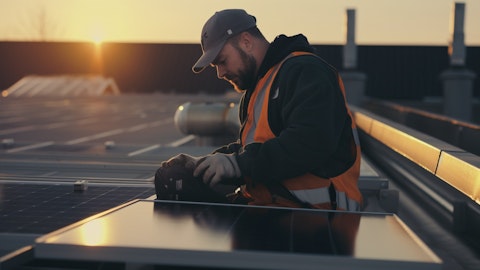Philip Shen: Thank you, Ronen. Best of luck.
Operator: We’ll move next to Mark Strouse with JPMorgan. Your line is open.
Mark Strouse: Yes, thank you very much for taking our questions. So outside of the pandemic years, just kind of looking back over your history, we’ve kind of thought about your ability to bring down your cost per watt kind of in the mid to high single digits or so. Looking forward to learning more about the new products you have coming out, but just kind of curious if you can talk generally, should we expect the efficiency improvements, the cost declines to kind of be in line with that versus kind of a step function change that you can talk about?
Zvi Lando: Yes, Mark. Thanks for the question, and I think you gave the answer yourself. So typically in the, over the life of a product or a generation of a product, we are able to reduce costs roughly at the rate that average prices decline in the market, so kind of a 10% per year. And then we’re able to take larger step cost reductions when we move to new generations, and especially when we’re moving to higher capacity generations. Because one of the advantages of our architecture is that on the module level electronics, the cost per watt is kind of fixed. But on the inverter side, we’re able to reduce the cost per watt with larger inverters. And when the market goes to larger systems, that enables cost reduction. So generally speaking, at the very high level, if you look at our next generation three phase inverter that I was discussing, that will enable a step function reduction of cost per watt compared to the current generation inverter for that size of an installation in the range of 30% to 50% in the shift between generations compared to the annual rate, if you will, of about 10%.
If that’s clear enough, Mark?
Mark Strouse: Yes, that’s very helpful. I look forward to seeing that. And then just a quick follow up Ronen. Just going back to the low margin single phase batteries, are you able to quantify what that inventory looks like? You said 2025, clearing a couple of times now. I’m just curious. I mean, with the crystal ball you have now, do you think that — later in the years, any color you have there would be great. Thank you.
Ronen Faier: Thanks, Mark. And first of all, by the way, looking at the industry performance in the last few quarters, crystal balls are not easy here. But in general, the way that we look at it is, this is basically a product that is based on around 1 gigawatt that we acquired from Samsung in here. Actually, we expected it always to be basically ending, if you remember in the history around the end of this year. Now, of course, that all in all, the industry is a little bit slower than it used to be. We believe that we will enter this market with this inventory into 2000 at 2025. And that will be the year that we believe that we’ll see some replacement with our new products. Now, the question here is going to be a combination of two things.
One is, again, to continue to see how the market adopts the product. And second will be when do we expect the product to be ready and Zvi we’ll talk about it in the next call. But we will make sure that we’re basically continuing with this product as much as needed in order to make sure that we have no product gap. The one thing I would say is that right now, it’s not just the fact that we’re selling these batteries a little bit faster than the others. It’s also the fact that the three phase batteries that are enjoying much better margins in Europe right now, the sales for them are relatively low given the situation in Europe. So when we look at the improvement of gross margins related to batteries into the end of this year and beginning of next year, it’s not just how quickly we’re clearing this, which is, of course, an important factor, but it’s also what portion of these batteries are within the overall residential batteries we sell right now.
This portion is very high. So all in all, middle of 2025. We believe that will be gone with this inventory.
Mark Strouse: Thank you.
Operator: And we’ll take our next question from Colin Rusch from Oppenheimer. Your line is open.
Colin Rusch: Thanks so much, guys. With the product redesigns in evolution, can you give us a sense of how much cost you feel like you could take out and how important is that to the margin trajectory that you guys are talking about getting back to a normalized level?
Zvi Lando: Yes. Hey Colin, thanks for the question. I think first the, and Ronen will correct me, the margin projections that Ronen was discussing before were not dependent on, on the new product that we will be releasing. Because the volumes, when we’re looking at the rest of this year, the volumes of the new products will not be impacting dramatically the financials, as I was alluding before, it varies from one different product. You take a battery, a battery that cost is very strongly dominated by the cells. So when you move from a current generation to a next generation, you’re dependent on cell prices. You can become more efficient on the mechanics and the power electronics. But your potential for cost reduction is at the end of the day, limited.
When you’re talking about the next generation of inverter new components and efficiencies, the potential for step function reduction in cost is much more significant. So as I was referring before to the new three phase inverter, taking into account when looking at the installation size that we’re targeting for that inverter. So the segment of a large residential installation, we will be able to serve with a solution that is probably in the range of about 50% lower cost per watt of the inverter, compared to serving that application with current generation inverters. That is not necessarily the cost reduction that will be achieved for every size of installation, but for the targets. And that’s how we do the design for target size and application that we think is going to be the main driver in the market.
And for that point, we optimize the cost. And like I say on the power electronics, in a generational move, we can be in the range of reducing the costs per watt of 30% to 50%.
Colin Rusch: That’s helpful guys. With the emergence of virtual power plants, both at the residential level, but more importantly at the commercial level, and some of the software investments that you guys have made, can you talk a little bit about your ability to monetize that and how quickly the evolution of those offerings are, what the cadence of that evolution is, and your ability to really get it embedded in with some of your customers, particularly on a commercial level?
Zvi Lando: So I would separate indeed between the VPP or virtual power plant is one application of grid services that is today more prevalent in residential than it is in commercial and we are able to monetize a subscription as long as the VPP program is active. I don’t remember off the top of my head, the number of batteries or residential systems that we have today under some form of a VPP. It is not huge. Otherwise we would have probably been able to report a much better margin because of 100% margin flow of cash. But VPP is growing, the growth rate is not huge and when it happens, we can generate revenue from it. The other software capabilities that we enable in residential for the most part, are not generating any type of revenue.
Commercial is a different story. What we are offering there is much, much broader than virtual power plant. It provides more value and it’s a wide range of capabilities from energy efficiency, load management, et cetera. And there we expect to be able to have a higher ratio of or relatively high ratio of software services and recurring revenue generation but it will be a process. It’s something that will be rolling out gradually and it will grow gradually again, I don’t see it having a big impact on our numbers in the next 24 months, but it is something that in the long run will be a source of high margin revenue.
Colin Rusch: Thanks so much.
Operator: We’ll move next to Austin Moeller with Canaccord. Your line is open.
Austin Moeller: Hi, good afternoon. Just my first question here. Do you see any potential changes to tariffs or legislation coming that could benefit U.S. made inverters and batteries similar to the recent change for bifacial panels?
Zvi Lando: Beyond the IRA, if you can help clarify the question.
Austin Moeller: The recent change was with tariff rules.
Zvi Lando: Yes, we’re not aware of anything. I think that said, the adoption of an increased use of bifacial panels is a good thing for module level power electronics providers because the incremental added harvest bi-module level power electronics from a bifacial panel is more significant than from a regular panel. But that’s completely a side note related to that regulation. We’re not aware of anything cooking of a similar nature in the space that we operate in.





